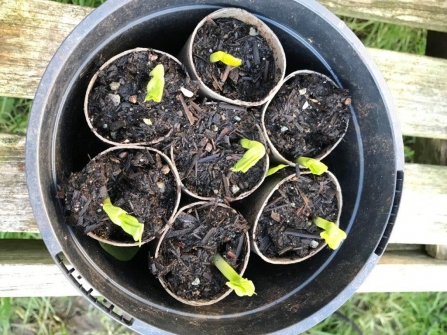A sunny day towards the end of February feels like a real bonus after weeks of wet and often windy weather, and with the tête-à-tête daffodils already out and the sound of birdsong all around, there’s a definite hint of spring in the air.
This is the kind of day that demands my presence on the allotment, although with a pile of ‘proper’ work to get through, I resolve to find a small task that will just require just an hour and make up the time I should have been sitting at my computer when it’s dark.
Evicting the Unwelcome
This policy is already yielding some satisfying results, allowing me to get stuck into the last blackberry plant that desperately required pruning and chip away at weeding the raised beds containing the strawberry plants, removing buttercups, dandelions and even a dock that have made themselves at home in the rich soil and replacing them with small runners that bailed out over the sides like little green parachutists towards the end of last summer.
Once this is done, and the soil ‘tickled’ with the blade of the weeding tool, I’ve been sprinkling around some chicken manure pellets to help feed these hard-working plants and covering them in compost sourced from an empty veg bed to deter local cats, the dog and badgers from helping themselves to these seemingly irresistible morsels of poo.
Wise Advice
Working away with the sun on my face is a pleasure, although a chill wind around my back calls to mind a sterling piece of advice that writer Tamsin Westhorpe gives to readers of her new book ‘Diary of a Modern Country Gardener’, published this month by Orphans Publishing.
Tamsin speaks from experience gained by working throughout the year at Stockton Bury Garden in Herefordshire, an enchanting spot created over many years by members of her family. She heartily recommends going out in ‘appropriate underwear’, including long-sleeved vests, something that would have been much better than an inadequate T shirt that refuses to stay tucked in my jeans as I bend over to pull out weeds.
An Early Treat
Harvesting is restricted to perennial kale and self-seeded chard, which are doing a great job in keeping my family in nutritious greens, and, much earlier than useful, rhubarb, which has perked up my breakfast porridge no end! A few pellets of chicken manure have been scattered around these leafy beauties by way of a thank you.
Elsewhere garlic and onions are growing well, encouraged by the mild weather and steady supply of moisture, and the lettuces that popped up around them continue to hang in there.
While my manic weeding means the bees and other insects won’t benefit from the blooms these plants would have eventually produced, I’ve tried to make it up to them by allowing other flowers to flourish in more appropriate spots. Several areas sown with phacelia are doing well and I’ve allowed a few borage plants to stay where they seeded themselves, positioning the old metal dustbins I use for growing carrots close behind them to make the best use of the surrounding space. In the section of the plot devoted to flowering plants I’m delighted to see that ox eye daisies, sweet rocket, green alkanet, red campion and violets are already growing well, together with rescued snowdrops, daffodils and tulips.
Preparations for the Months Ahead
At home the onset of spring is heralded by the length of the shoots on the potatoes chitting away in the bathroom, together with the emerging broad beans, peas and sweet peas sown in toilet tissue tubes on the windowsills that will be on their way to a sheltered spot outside in a day or two to avoid them becoming ‘leggy’ through growing too quickly in a warm environment.
Occasional walks around our village reveal the extent of the damage wrecked by the wind. The caretaker at our local school has filled a few bags with fallen branches and other detritus, which I’ve taken up to the allotment to make little piles for reptiles and beetles. In time nutrients will be released into the soil as these pieces of dead wood rot down.
It’s clear the allotment is coming to the end of its winter snooze and, as emerging weed seedlings testify, there are just a few short weeks left to complete any remaining pruning jobs before it’s time to get the soil ready so that sowing to begin. The clock is ticking seemingly faster than usual this year, although I know better than to underestimate the ability of winter to have one or two tricks left up its long, dark sleeve.

